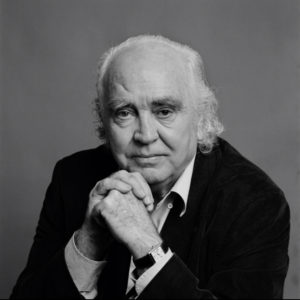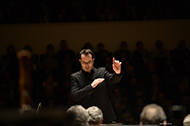Commissions 2019/2020 Season
A commitment to new work and contemporary creation is one of the artistic values with unites the diverse member halls of the ECHO network. Collectively and individually our history is a strong and proud one. Many of the worlds leading artists have performed within our venues and countless significant world premieres in musical history have taken place within our venues. And this continues to be the case today, an enduring passion and commitment with an much broader range and reach in terms of styles, events, programmes, audiences and communities reached. On almost any day of the year you can find a breath taking choice and diversity of musical experiences within the ECHO halls.

MOLLY KEIN Hydrozoa
Written for: Magnus Holmander, clarinet
World premiere: 8.11.2019, Müpa Budapest
“The piece with Molly Kien is called Hydrozoa and is inspired by the sea-animal with the same name. In this piece I will be using a completly new technique called Sensor Augmented Clarinet, invented by Robert Ek. Instead of using a normal bell on the clarinet I will use a special bell that can sense movements. By moving the clarinet in different directions (while playing) I can create different effects such as looping, bending the note and much more.”

ANTON GARCIA ABRIL “From the cry of silence” (Imaginary concert, for solo cello)
Written for: Pablo Ferrández, ‘cello
World premiere: 13.10.2019, Philharmonie Cologne
“Always when taking on the task of writing a specific composition for a project with defined characteristics, the disturbing and permanent question mark on the path that I will have to travel arises in my mind. When I started composing, and after drafting the first creative impulses focused on the classical cello and piano duet, I decided to structure the work around the attractive composition technique given by the cello as a soloist instrument, knowing the difficulties that this type of writing implied, but guided especially by the multiple expressive possibilities given by the powerful voice of the cello in its purest form. It hasn’t been long since Pablo Ferrández premiered my “Variations for cello and orchestra” in Madrid. Since this first meeting I have admired his vision on the art of interpretation. I discovered his way of deepening in a new work, based on the study and analysis of the constitutive elements that define each composition. There is no doubt that knowing the artistic personality of Pablo Ferrández and knowing his great interpretative possibilities, he has had a very direct influence on my compositional technique and allowed me to create a work designed with great freedom. I thank Pablo for offering me, with this assignment, the opportunity to create this imaginary concert: it was worth it. The title “From the cry of silence” corresponds to the first verse of a short poem I wrote. Music and poetry are shown as two branches of the same tree.”

DOBRINKA TABAKOVA The Smile of the Flamboyant Wings
Written for: Aris Quartett
World premiere: 8.11.2019, Müpa Budapest
The work takes its name from Joan Miro’s painting of the same name, though it is not meant as a musical representation of the art work. If there are any similarities with the painting and Miro’s work, they would take broader themes such as the relationship between the linear and horizontal and the interplay between used and free space on the canvas. Following Tabakova’s Spinning a Yarn (for violin and hurdy-gurdy), On a bench in the shade (for string quartet) and Frozen River Flows (violin, accordion and bass), the music itself aims to be a story told in music. The elaborately rhythmic opening and flowing, unpredictable melody set the scene, before chorale-like middle section and a transformed melody at the end. The work is written especially for the Goldmund Quartet and commissioned by Cité de la Musique – Philharmonie de Paris, Festspielhaus Baden Baden and the European Concert Hall Organisation in the framework of ECHO Rising Stars.

JOEY ROUKENS SARASVATI, for violin and piano (2018)
Written for: Noa Wildschut, violin
World premiere: 18.01.2020, Sage Gateshead
“‘Sarasvati’ is an old Sanskrit word originally meaning ‘that which flows’ or ‘river’: it was the name of both a mythical ‘disappeared’ river in ancient India and a Hindu goddess, who was originally a personification of this river but who later developed into the Hindu goddess of learning and music. The goddess Sarasvati is still worshipped today in Asian countries such as India and Indonesia. When writing this piece I had the image of a flowing river in mind, a river which flows quietly and peacefully at first, but then gradually becomes wilder and rougher until it fiercely rushes into the sea. And since the musical material also makes use of certain Eastern elements (which may sometimes remind the listener of Indian or Indonesian music), I felt ‘Sarasvati’ was a fitting title. In the course of twelve and a half minutes, the piece thus gradually progresses from a lyrical and serene kind of music to an ever more joyful and virtuosic ecstasy – a form which was more or less suggested by Noa herself when I asked her whether she had any wishes about the kind of piece she wanted from me.”

MIROSLAV SRNKA Milky Way
Written for Simon Höfele, trumpet
World premiere: 25.09.2019, Het Concertgebouw Amsterdam
“From anywhere else in the Milky Way, our Sun is a rising star.
For the ECHO rising star Simon Höfele”

YANN ROBIN E[n]igma
Written for: João Barradas, accordion
World premiere: 18.01.2020, Sage Gateshead
“The title of a piece, whether comprised of a word, a phrase, a number, or more generically, symbols, reveals an inspiration and, as a consequence, orients listening. Every word has a meaning, a specific connotation in relation to the context in which it is being used. If we add a foreign “character” to the word/words of this/these titles, do we create a semantic gap? Do we disrupt the word’s intrinsic nature? Does the title of this piece, E[n]igma, contain a hidden mystery simply due to having imprisoned the second letter between brackets, the [n]? Why were these “brackets” added? What is the connotation, the meaning? What do they infer? Providing a response to these unanswered questions interrupts the charm produced by that unresolved enigma. It is rather up to each person to discover the hidden meaning, by listening…”